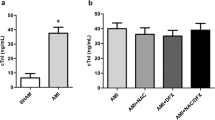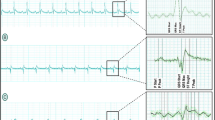Abstract
Aims: We evaluated the effect of N-acetylcysteine (NAC, infused i.v.), isosorbide 5-mononitrate (IS5MN, by gavage), or their combination on cardiac injury in an in vivo rat model of 30-min ischemia followed by 24 hours or 7 days of reperfusion.
Results: When administered immediately prior to reperfusion with continuous infusion for 24 h, the combination of NAC + IS5MN reduced infarct size (29 ± 6 vs. 59 ± 4% area-at-risk, p < 0.01) and the infiltration of polymorphonuclear leukocytes (226 ± 15 vs. 315 ± 18 cells mm−2 of area-at-risk, p = 0.002) and monocytes/macrophages (118 ± 8 vs. 194 ± 22 cells mm−2, p = 0.012), compared to vehicle. NAC or IS5MN alone did not reduce infarct size at 24 hours of reperfusion. The same dose regimen of NAC and IS5MN did not reduce infarct size with permanent ischemia for 24 hours not followed by reperfusion. After 7 days of reperfusion (3 days of treatment with NAC + IS5MN or vehicle and 4 days of wash-out), infarct size was similar in the vehicle and NAC + IS5MN groups, but LV end-diastolic pressure and diastolic LV chamber wall stress were significantly lower in the animals treated with NAC + IS5MN (5 ± 1 mmHg and 62 ± 7 dyne mm−2, respectively) compared to vehicle (9 ± 1 mmHg and 123 ± 18 dyne mm−2, p < 0.05).
Conclusion: We demonstrate in a rat model of cardiac ischemia-reperfusion treated with NAC and IS5MN, according to a regimen that mimicked a clinical situation (drugs started at time of reperfusion), that the short-term benefit seen after 24 h of reperfusion (51% reduction of infarct size) is maintained after one week, possibly through modulation of the inflammatory response to cardiac injury.
Similar content being viewed by others
References
Verma S, Fedak PWM, Weisel RD, et al. Fundamentals of reperfusion injury for the clinical cardiologist. Circulation 2002;105:2332-2336.
Hearse DJ, Humphrey SM, Chain EB. Abrupt reoxygenation of the anoxic potassium-arrested perfused rat heart: A study of myocardial enzyme release. J Molec Cell Cardiol 1973;5:395-407.
Kaplan P, Lehotsky J, Racay P. Role of sarcoplasmic reticulum in the contractile dysfunction during myocardial ischemia and reperfusion. Physiol Res 1997;46:333-339.
Bolli R, Jeroudi MO, Patel BS, et al. Direct evidence that oxygen-derived free radicals contribute to postischemic myocardial dysfunction in the intact dog. Proc Natl Acad Sci (USA) 1989;86:4695-4699.
Dhalla NS, Elmoselhi AB, Hata T, Makino N. Status of myocardial antioxidants in ischemia-reperfusion injury. Cardiovasc Res 2000;47:446-456.
Lesnefsky EJ, Dauber IM, Horwitz LD. Myocardial sulfhydryl pool alterations during reperfusion after brief and prolonged myocardial ischemia in vivo. Circ Res 1991; 68:605-613.
Ramires PR, Ji LL. Glutathione supplementation and training increases myocardial resistance to ischemia-reperfusion in vivo. Am J Physiol 2001;281:H679-H688.
Sochman J, Kolc J, Vrana M, Fabian J. Cardioprotective effects of N-acetylcysteine: The reduction in the extent of infarction and occurrence of reperfusion arrhythmias in the dog. Int J Cardiol 1990;28:191-196.
Aruoma OI, Halliwell B, Hoey BM, Butler J. The antioxidant action of N-acetylcysteine: Its reaction with hydrogen peroxide, hydroxyl radical, superoxide, and hypochlorous acid. Free Radic Biol Med 1989;6:593-597.
Horowitz JD, Antman EM, Lorell BH, Barry WH, Smith TW. Potentiation of the cardiovascular effects of nitroglycerin by N-acetylcysteine. Circulation 1983;68:1247-1253.
Mehara A, Shotan A, Ostrzega E, Hsueh W, Vasquez-Johnson J, Elkayam U. Potentiation of isosorbide dinitrate effects with N-acetylcysteine in patients with chronic heart failure. Circulation 1994;89:2595-2600.
Arstall MA, Yang J, Stafford I, Betts WH, Horowitz JD. Nacetylcysteine in combination with nitroglycerin and streptokinase for the treatment of evolving acute myocardial infarction. Circulation 1995;92:2855-2862.
Ardissino D, Merlini PA, Savonitto S, et al. Effect of transdermal nitroglycerin or N-acetylcysteine, or both, in the long-term treatment of unstable angina pectoris. J Am Coll Cardiol 1997;29:941-947.
Ignarro LJ, Lippton H, Edwards JC, et al. Mechanism of vascular smooth muscle relaxation by organic nitrates, nitrites, nitroprusside and nitric oxide: Evidence for the involvement of S-nitrosothiols as active intermediates. J Pharmacol Exp Ther 1981;218:739-749.
Loscalzo J. N-acetylcysteine potentiates inhibition of platelet aggregation by nitroglycerin. J Clin Invest 1985;76: 703-708.
Stamler J, Mendelsohn ME, Amarante P, et al. Nacetylcysteine potentiates platelet inhibition by endothelium-derived relaxing factor. Circ Res 1989;65:789-795.
Cooke JP, Stamler J, Andon N, Davies PF, McKinley G, Loscalzo J. Flow stimulates endothelial cells to release a nitrovasodilator that is potentiated by reduced thiol. Am J Physiol 1990;259:H804-H812.
Scharfstein JS, Keany JF, Jr, Slivka A, et al. In vivo transfer of nitric oxide between a plasma protein-bound reservoir and low molecular weight thiols. J Clin Invest 1994;94:1432-1439.
Elkayam U. Tolerance to organic nitrates: Evidences, mechanisms, clinical relevance and strategies for prevention.Ann Intern Med 1991;14:667-677.
Parker JO, Farrel B, Lahey KA, Rose BF. Nitrate tolerance: The lack of effect of N-acetylcysteine. Circulation 1987;76:572-576.
Forman MB, Puett DW, Cates CU, et al. Glutathione redox pathway and reperfusion injury. Effect of N-acetylcysteine on infarct size and ventricular function. Circulation 1988;78:202-213.
Tripathi Y, Hedge BM. Effect of N-acetylcysteine on myocardial infarct size and reperfusion in dogs. Indian J Physiol Pharmacol 1998;42:50-56.
Kingma JG, Jr, Rouleau JL. Effect of N-acetylcysteine on tissue necrosis during acute myocardial infarction in rabbits. Can J Cardiol 1989;5:321-326.
Alberola A, Such L, Gil F, Zaragoza R, Morcillo EJ. Protective effect of N-acetylcysteine on ischaemia-induced myocardial damage in canine heart. Naunyn-Schmiederberg's Arch Pharmacol 1991;343:505-510.
Jugdutt B. Myocardial salvage by intravenous nitroglycerin in conscious dogs: Loss of beneficial effect with marked nitroglycerin-induced hypotension. Circulation 1983;68: 673-684.
Chiariello M, Brevetti G, Ambrosio G, Cataffo A, Pollice U, Condorelli M. Long-term protection of ischemic myocardium by nitroglycerin ointment. Cardiovasc Res 1984;8:321-325.
Anversa P, Beghi C, Kikkawa Y, Olivetti G. Myocardial response to infarction in the rat. Morphometric measurement of infarct size and myocyte cellular hypertrophy. Am J Pathol 1985;18:484-492.
Davreux CJ, Soric I, Nathens AB, et al. N-acetyl cysteine attenuates acute lung injury in the rat. Shock 1997;8:432-438.
Schmidt W, Walther A, Gebhard MM, Martin E, Schmidt H. Influence of N-acetylcysteine treatment on endotoxininduced microcirculatory disturbances. Intensive Care Med 1998;24:967-972.
Victor VM, Guayerbas N, Garrotte M, Del Rio M, De La Fuente M. Modulation of murine macrophage function by N-acetylcysteine in a model of endotoxic shock. BioFactors 1999;10:347-357.
Cuzzocrea S, Mazzon E, Costantino G, Serraino I, De Sarro A, Caputi A. Effects of N-acetylcysteine in a rat model of ischemia and reperfusion injury. Cardiovasc Res 2000;47:537-548.
Riva E, Kurosaki M, Porzio S, Latini R, Lagrasta C, Olivetti G. Effects of an early treatment with lisinopril and isosorbide-5-mononitrate on hemodynamics and late ventricular remodelling in rats with 9-week myocardial infarction. Cardioscience 1995;6:139-146.
Hansen PR. Role of neutrophils in myocardial ischemia and reperfusion. Circulation 1995;91:1872-1885.
Latini R, Masson S, Bertini R, Maggioni AP, Ghezzi P, Calvillo L. Cardiac protection by pharmacological modulation of inflammation. Expert Opin Investig Drugs 2001; 10:1913-1924.
Weber C, Erl W, Pietsch A, Strobel M, Ziegler-Heitbrock HW, Weber PC. Antioxidants inhibit monocyte adhesion by suppressing nuclear factor-kappa B mobilization and induction of vascular cell adhesion molecule-1 in endothelial cells stimulated to generate radicals. Arterioscler Thromb 1994;4:1665-1673.
Schmidt H, Schmidt W, Muller T, Bohrer H, Gebhard MM, Martin E. N-acetylcysteine attenuates endotoxininduced leukocyte-endothelial cell adhesion and macromolecular leakage in vivo. Crit Care Med 1997;25:858-863.
Ghezzi P, Dinarello CA, Bianchi M, Rosandich ME, Repine JE, White CW. Hypoxia increases production of interleukin-1 and tumor necrosis factor by human mononuclear cells. Cytokine 1991; 3:189-194.
Peristeris P, Clark BD, Gatti S, et al. N-acetylcysteine and glutathione as inhibitors of tumor necrosis factor production. Cell Immunol 1992;40:390-399.
Leff JA, Wilke CP, Hybertson BM, Shanley PF, Beehler CJ, Repine JE. Postinsult treatment with N-acetyl-L-cysteine decreases IL-1-induced neutrophil influx and lung leak in rats. Am J Physiol 1993; 265:L501-L506.
Sato M, Miyazaki T, Nagaya T, et al. Antioxidants inhibit tumor necrosis factor-alpha mediated stimulation of interleukin-8, monocyte chemoattractant protein-1, and collagenase expression in cultured human synovial cells. J Rheumatol 1996; 23:432-438.
Schreck R, Rieber P, Baeuerle PA. Reactive oxygen intermediates as apparently widely used messengers in the activation of the NF-kappa B transcription factor and HIV-1. EMBO J 1991;10:2247-2258.
Cargnoni A, Ceconio C, Gaia G, Agnoletti L, Ferrari R. Cellular thiols redox status: A switch for NF-kB activation during myocardial post-ischaemic reperfusion. J Molec CellCardiol 2002;34:997-1005.
Marui N, Offermann MK, Swerlick R, et al. Vascular cell adhesion molecule-1 (VCAM-1) gene transcription and expression are regulated through an antioxidant-sensitive mechanism in human vascular endothelial cells. J Clin Invest 1993,92:1866-1874.
Maekawa N, Wada H, Kanda T, et al. Improved myocardial ischemia/reperfusion injury in mice lacking tumor necrosis factor-alpha. J Am Coll Cardiol 2002;39:1229-1235.
Sargent CA, Sleph PG, Dzwnczyk S, et al. Cardioprotection in ischemic rat hearts with SH-containing angiotensinconverting enzyme inhibitor zofenopril: Possible involvement of the ATP-sensitive potassium channel. J Pharmacol Exp Ther 1993;265:609-618.
Buikema H, Monnink SHJ, Tio RA, Crijns HJGM, De Zeeuw D, Van Gilst WH. Comparison of zofenopril and lisinopril to study the role of the sulfhydryl-group in improvement of endothelial dysfunction with ACE-inhibitors in experimental heart failure. Br J Pharmacol 2000;30:1999-2007.
Andrews NP, Prassad A, Quyyumi AA. N-acetylcysteine improves coronary and peripheral vascular function. J Am Coll Cardiol 2001;37:117-123.
Daemen MA, van't Veer C, Denecker G, et al. Inhibition of apoptosis induced by ischemia-reperfusion prevents inflammation. J Clin Invest 1999;104:541-549.
Rabuffetti M, Sciorati C, Tarozzo G, Clementi E, Manfredi AA, Beltramo M. Inhibition of caspase-1-like activity by Ac-Tyr-Val-Ala-Asp-chloromethyl ketone induces long-lasting neuroprotection in cerebral ischemia through apoptosis reduction and decrease of proinflammatory cytokines. J Neurosci 2000;20:4398-4404.
Inserte J, Taimor G, Hofstaetter B, Garcia-Dorado D, Piper HM. Influence of simulated ischemia on apoptosis induction by oxidative stress in adult cardiomyocytes of rats. Am J Physiol 2000;278:H94-H99.
Yamamoto S, Seta K, Morisco C, Vatner SF, Sadoshima J. Chelerythrine rapidly induces apoptosis through generation of reactive oxygen species in cardiac myocytes.J Molec Cell Cardiol 2001;33:1829-1848.
Mannisi JA, Weisman HF, Bush DE, Dudeck P, Healy B. Steroid administration after myocardial infarction promotes early infarct expansion. J Clin Invest 1987;79:1431-1439.
Galie N, Guarnieri C, Ussia GP, et al. Limitation of myocardial infarct size by nicorandil after sustained ischemia in pigs. Br J Pharmacol 1995;26:477-484.
Author information
Authors and Affiliations
Rights and permissions
About this article
Cite this article
Calvillo, L., Masson, S., Salio, M. et al. In Vivo Cardioprotection by N-Acetylcysteine and Isosorbide 5-Mononitrate in a Rat Model of Ischemia-Reperfusion. Cardiovasc Drugs Ther 17, 199–208 (2003). https://doi.org/10.1023/A:1026182404805
Issue Date:
DOI: https://doi.org/10.1023/A:1026182404805




